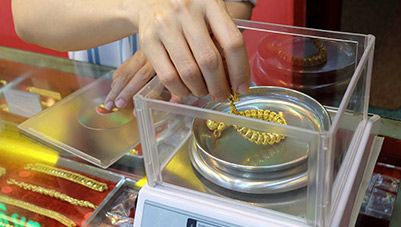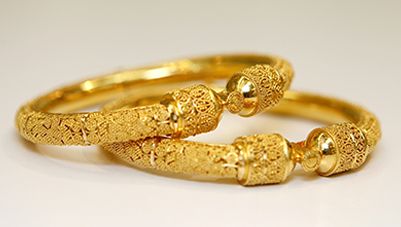Rs. 5,000 - Rs. 2 crore
Understanding gold karats and their role in valuation
Gold holds significant cultural and financial importance in India, serving both as a precious metal and a financial asset. Gold karats denote the purity of gold, with 24 karats being pure gold. In India, gold is often used as collateral for loans, known as gold loans. These loans are popular due to gold's liquidity and stable value. Financial institutions and banks accept gold ornaments or coins as collateral against which they provide loans at competitive interest rates. The loan amount typically ranges from a percentage of the gold's value, ensuring quick access to funds without extensive documentation or credit checks. Gold loans play a crucial role in meeting short-term financial needs, especially in rural areas where access to formal banking services may be limited. As a result, gold continues to be not only a cultural symbol but also a practical financial resource for many in India.
What is gold carat?
Gold carats is a measure of the purity of gold used in jewellery. Understanding the gold carat list helps you know how pure your jewellery is. There are different types of gold karats, such as 24K, 22K, 18K, and 14K, which represent the types of carats in gold available in the market. Each type of gold carat is suitable for different uses, from investment to daily wear jewellery. Learning about the types of karat gold also answers the common question, What are the 3 types of gold, helping buyers choose wisely before purchasing.
How gold karats are measured and defined
Gold karats are used to measure the purity of gold in jewellery and coins. Understanding the gold carat list and different types of gold karats is essential before buying gold. Here is how they are measured and defined:
- Measurement scale: Gold purity is measured on a scale of 24 parts. Pure gold is 24K, meaning all 24 parts are gold.
- Types of carat in gold: The most common types of karat gold are 24K, 22K, 18K, and 14K, with each having a different percentage of gold.
- Use of alloys: Lower karat gold contains metals like silver or copper for strength, making it suitable for daily wear.
- Buyer’s guide: Knowing the type of gold carat helps you decide based on durability, cost, and purpose.
- Understanding choices: Learning what the 3 types of gold make comparing options easier.
Purity and impurity: Understanding the gold carat range
Remember at all times that hardness and purity dance together as we navigate the maze of gold carats. Larger carats correspond with purer gold, but this also highlights the metal's softer side. Conversely, lower-carat gold retains the strength of alloys, ensuring resilience without compromising brightness. The outcome of a dance of components is jewellery with individuality; these pieces endure in terms of both shape and emotion.
The purity, composition, and salient features of each gold carat are listed in the table below
| Carat | Purity (%) | Alloy Composition | Notable Characteristics |
| 14K | 58.3 | Copper, Silver | Durability, Ideal for daily wear |
| 18K | 75 | Copper, Silver | The balance between purity and durability |
| 22K | 91.7 | Alloy Additives | Radiant hue, Suitable for intricate designs |
| 24K | 99.9 | Pure Gold | Ultimate purity, Ideal for investment |
How gold carat affects gold loan value
Gold loans are secured loans where gold ornaments are used as collateral. The loan amount is determined by the value of the gold, which is influenced by its carat. Carat measures the purity of gold, with 24 carats being the highest quality. A higher carat value indicates greater purity, leading to a larger loan amount.
Gold loan is preferred for its swift processing, minimal documentation, and alleviation of credit score concerns. They can be used for various needs like education, medical emergencies, or home repairs. Gold loan interest rates are relatively lower than other loans, ranging from 9.50% to 24% p.a. These rates can vary based on factors like the lender, loan tenure, and fluctuations in gold prices. It’s crucial to compare the rates offered by various lenders to secure the most favourable terms.
Wondering how much you can borrow on your gold? Just check your gold loan eligibility—it takes seconds and minimal paperwork!
Factors influencing loan amount based on gold carat
Gold loans are a popular form of credit in many countries, offering quick access to funds by leveraging the value of gold. However, the loan amount one can secure is influenced by several factors related to the gold’s carat and other considerations.
- Gold’s purity and weight: The primary factor is the purity and weight of the gold pledged. The gold should be of 18 carats or above.
- Market value of gold: The current market value of gold is critical. Fluctuations in the market price directly impact the baseline value of the gold loan.
- Income of the borrower: The borrower’s monthly income is also considered while processing a gold loan request.
- Credit score: The borrower’s credit score can affect the interest rate, which indirectly influences the loan amount.
- Loan tenure: The amount and tenure of the loan also influence the interest rate, affecting the loan amount.
While the carat of gold is a significant factor, it’s not the only one. Other elements like the borrower’s income, credit score, and the current market value of gold also play a crucial role. Therefore, it’s advisable to understand these factors and check the specific terms and conditions before applying for a gold loan.
Conclusion
In conclusion, while the carat quality of gold is a crucial factor in securing a gold loan, other factors such as interest rates, repayment methods, and processing fees also play a significant role. By considering these tips, borrowers can ensure they secure the best possible terms for their gold loan.
Ready to unlock the value of your gold? Apply for Bajaj Finserv Gold Loan today.
Different types of gold karat
Videos
Gold has been priced for thousands of years because of its inherent beauty, brilliance, and adaptability. Because of these characteristics, it is the most significant metal in jewellery-making. When purchasing gold jewellery, you have a variety of gold hue, plating, and carat options to choose from. The first item you ought to consider is the carat. The carat system ranges from 24K, representing pure gold, to lower values indicating a higher percentage of other metals. Each type of gold, whether it’s 24K, 22K, 18K, or 14K, has its unique characteristics and applications. Here are the other types of gold karat:
- 10 Carat Gold: 10K gold has 41.6% purity of gold and 58.4% other metals, making it durable and affordable, but with a paler yellow colour.
- 12 Carat Gold: 12K gold contains 50% pure gold and 50% other metals, offering good durability and affordability but a lighter tone than higher karats.
- 14 Carat Gold: 14K gold has 58.3% pure gold, balancing durability and beauty, making it popular for everyday jewellery and engagement rings.
- 18 Carat Gold: 18K gold is 75% pure, combining strength with rich colour, often chosen for luxurious yet durable jewellery.
- 20 Carat Gold: 20K gold has 83.3% purity, giving it a warmer tone, but it is less common due to its higher price and softness.
- 22 Carat Gold: 22K gold is 91.7% pure, bright and malleable, ideal for traditional jewellery, though slightly less durable than lower karats.
- 24 Carat Gold: 24K gold is 99.9% pure, rich in colour and value, perfect for investment but too soft for intricate jewellery.
It takes just 2 steps to check your eligibility for a Bajaj Finserv Gold Loan. Enter your mobile number now.
Tips for getting the best gold loan based on carat quality
Gold loans are a popular form of credit in many countries, offering quick access to funds by leveraging the value of gold. However, the loan amount one can secure is influenced by several factors related to the gold’s carat and other considerations.
- Gold’s purity and weight: The primary factor is the purity and weight of the gold pledged. The gold should be of 18 carats or above.
- Market value of gold: The current market value of gold is critical. Fluctuations in the market price directly impact the baseline value of the gold loan.
- Income of the borrower: The borrower’s monthly income is also considered while processing a gold loan request.
- Credit score: The borrower’s credit score can affect the interest rate, which indirectly influences the loan amount.
- Loan tenure: The amount and tenure of the loan also influence the interest rate, affecting the loan amount.
- Processing fee and appraiser charges: Banks may charge a processing fee and appraiser charges, which could affect the final loan amount.
Apply in minutes. Money in account instantly with a Bajaj Finserv Gold Loan*
Related Articles
Disclaimer
Bajaj Finance Limited has the sole and absolute discretion, without assigning any reason to accept or reject any application. Terms and conditions apply*.









 Savings Offer
Savings Offer Smartphones
Smartphones LED TVs
LED TVs Refrigerators
Refrigerators Washing Machines
Washing Machines Laptops
Laptops
 Deals starting @99
Deals starting @99 Festive deals
Festive deals Min. 50% off
Min. 50% off
 Wallet to Bank
Wallet to Bank
 Easy EMI Loan
Easy EMI Loan Savings Offer
Savings Offer Smartphones
Smartphones Led TVs
Led TVs Washing Machines
Washing Machines Laptops
Laptops Refrigerators
Refrigerators Air Conditioner
Air Conditioner Air Coolers
Air Coolers
 Loan Against Shares
Loan Against Shares Loan Against Mutual Funds
Loan Against Mutual Funds Loan Against Insurance Policy
Loan Against Insurance Policy ESOP Financing
ESOP Financing Easy EMI Loan
Easy EMI Loan Two-wheeler Loan
Two-wheeler Loan Loan for Lawyer
Loan for Lawyer Industrial Equipment Finance
Industrial Equipment Finance Industrial Equipment Balance Transfer
Industrial Equipment Balance Transfer Industrial Equipment Refinance
Industrial Equipment Refinance Personal Loan Branch Locator
Personal Loan Branch Locator Used Tractor Loan
Used Tractor Loan Loan Against Tractor
Loan Against Tractor Tractor Loan Balance Transfer
Tractor Loan Balance Transfer
 Two-wheeler Loan
Two-wheeler Loan Bike
Bike Scooter
Scooter Electric Vehicle
Electric Vehicle Best Sellers
Best Sellers Popular Brands
Popular Brands

 Trading Account
Trading Account Open Demat Account
Open Demat Account Margin Trading Financing
Margin Trading Financing Share Market
Share Market Invest in IPO
Invest in IPO All stocks
All stocks Top gainers
Top gainers Top losers
Top losers 52 week high
52 week high 52 week low
52 week low Loan against shares
Loan against shares
 Home Loan
Home Loan Transfer your existing Home loan
Transfer your existing Home loan Loan against Property
Loan against Property Home Loan for Salaried
Home Loan for Salaried Home loan for self employed
Home loan for self employed Home Loan EMI Calculator
Home Loan EMI Calculator Home Loan eligibility calculator
Home Loan eligibility calculator Home Loan balance transfer
Home Loan balance transfer
 Term Life Insurance
Term Life Insurance ULIP Plan
ULIP Plan Savings Plan
Savings Plan Family Insurance
Family Insurance Senior Citizen Health Insurance
Senior Citizen Health Insurance Critical Illness Insurance
Critical Illness Insurance Child Health Insurance
Child Health Insurance Pregnancy and Maternity Health Insurance
Pregnancy and Maternity Health Insurance Individual Health Insurance
Individual Health Insurance Low Income Health Insurance
Low Income Health Insurance Student Health Insurance
Student Health Insurance Group Health Insurance
Group Health Insurance Retirement Plans
Retirement Plans Child Plans
Child Plans Investment Plans
Investment Plans
 Business Loan
Business Loan Secured Business Loan
Secured Business Loan Loan against property
Loan against property Loans against property balance transfer
Loans against property balance transfer Loan against shares
Loan against shares Home Loan
Home Loan Loans against mutual funds
Loans against mutual funds Loan against bonds
Loan against bonds Loan against insurance policy
Loan against insurance policy
 Apply for Gold Loan
Apply for Gold Loan Transfer your Gold Loan with Us
Transfer your Gold Loan with Us Gold Loan Branch Locator
Gold Loan Branch Locator
 ULIP Plan
ULIP Plan Savings Plan
Savings Plan Retirement Plans
Retirement Plans Child Plans
Child Plans Free Demat Account
Free Demat Account Invest in Stocks
Invest in Stocks Invest in IPO
Invest in IPO Margin Trading Facility
Margin Trading Facility Fixed Deposit Branch Locator
Fixed Deposit Branch Locator
 Check your Credit Score
Check your Credit Score
 New Car Loan
New Car Loan Used Car Loan
Used Car Loan Loan Against Car
Loan Against Car Car Loan Balance Transfer and Top-up
Car Loan Balance Transfer and Top-up
 Get Bajaj Prime
Get Bajaj Prime
 Mobiles on EMI
Mobiles on EMI Electronics on EMI Offer
Electronics on EMI Offer  Iphone on EMI
Iphone on EMI LED TV on EMI
LED TV on EMI Refrigerator on EMI
Refrigerator on EMI Laptop on EMI
Laptop on EMI Kitchen appliances on EMI
Kitchen appliances on EMI Washing machines
Washing machines
 Personal Loan EMI Calculator
Personal Loan EMI Calculator Personal Loan Eligibility Calculator
Personal Loan Eligibility Calculator Home Loan EMI Calculator
Home Loan EMI Calculator Home Loan Eligibility Calculator
Home Loan Eligibility Calculator Good & Service Tax (GST) Calculator
Good & Service Tax (GST) Calculator Flexi Day Wise Interest Calculator
Flexi Day Wise Interest Calculator Flexi Transaction Calculator
Flexi Transaction Calculator Secured Business Loan Eligibility Calculator
Secured Business Loan Eligibility Calculator Fixed Deposits Interest Calculator
Fixed Deposits Interest Calculator Two wheeler Loan EMI Calculator
Two wheeler Loan EMI Calculator New Car Loan EMI Calculator
New Car Loan EMI Calculator Used Car Loan EMI Calculator
Used Car Loan EMI Calculator All Calculator
All Calculator
 Hot Deals
Hot Deals Clearance Sale
Clearance Sale Kitchen Appliances
Kitchen Appliances Tyres
Tyres Camera & Accessories
Camera & Accessories Mattresses
Mattresses Furniture
Furniture Watches
Watches Music & Audio
Music & Audio Cycles
Cycles Mixer & Grinder
Mixer & Grinder Luggage & Travel
Luggage & Travel Fitness Equipment
Fitness Equipment Fans
Fans
 Personal Loan for Doctors
Personal Loan for Doctors Business loan for Doctors
Business loan for Doctors Medical Equipment Finance
Medical Equipment Finance Secured Business Loan
Secured Business Loan Loan against property
Loan against property Secured Business Loan Balance Transfer
Secured Business Loan Balance Transfer Loan against share
Loan against share Gold Loan
Gold Loan Home Loan
Home Loan
 Engagement Zone
Engagement Zone Game Zone
Game Zone
 Savings Offer
Savings Offer Easy EMI
Easy EMI Offer World
Offer World 1 EMI OFF
1 EMI OFF New Launches
New Launches Zero Down Payment
Zero Down Payment Clearance Sale
Clearance Sale Bajaj Mall Sale
Bajaj Mall Sale
 Mobiles under ₹20,000
Mobiles under ₹20,000 Mobiles under ₹25,000
Mobiles under ₹25,000 Mobiles under ₹30,000
Mobiles under ₹30,000 Mobiles under ₹35,000
Mobiles under ₹35,000 Mobiles under ₹40,000
Mobiles under ₹40,000 Mobiles under ₹50,000
Mobiles under ₹50,000
 Articles
Articles
 Overdue Payments
Overdue Payments Other Payments
Other Payments
 Document Center
Document Center Bank details & Documents
Bank details & Documents Tax Invoice Certificate
Tax Invoice Certificate
 Do Not Call Service
Do Not Call Service
 Your Orders
Your Orders Hamara Mall Orders
Hamara Mall Orders

 Faster, Easier Gold Loan
Faster, Easier Gold Loan Digi Sarkar
Digi Sarkar Used Tractor Loan
Used Tractor Loan Check Loan Offer
Check Loan Offer Mobiles on EMI
Mobiles on EMI ITR
ITR My Garage
My Garage Trade directly with your Demat A/c
Trade directly with your Demat A/c
 Live Videos - Beta
Live Videos - Beta
 Easy EMI Loan
Easy EMI Loan Savings Offer
Savings Offer Smartphones
Smartphones LED TVs
LED TVs Washing Machines
Washing Machines Laptops
Laptops Refrigerators
Refrigerators Air Conditioners
Air Conditioners Air Coolers
Air Coolers Water Purifiers
Water Purifiers Tablets
Tablets Kitchen Appliances
Kitchen Appliances Mattresses
Mattresses Furniture
Furniture Music and Audio
Music and Audio Cameras & Accessories
Cameras & Accessories Cycle
Cycle Watches
Watches Tyres
Tyres Luggage & Travel
Luggage & Travel Fitness Equipment
Fitness Equipment Tractor
Tractor
 vivo Mobiles
vivo Mobiles OPPO Mobiles
OPPO Mobiles Xiaomi Mobiles
Xiaomi Mobiles Sony LED TVs
Sony LED TVs Samsung LED TVs
Samsung LED TVs LG LED TVs
LG LED TVs Haier LED TVs
Haier LED TVs Godrej Refrigerators
Godrej Refrigerators Voltas Washing Machines
Voltas Washing Machines










